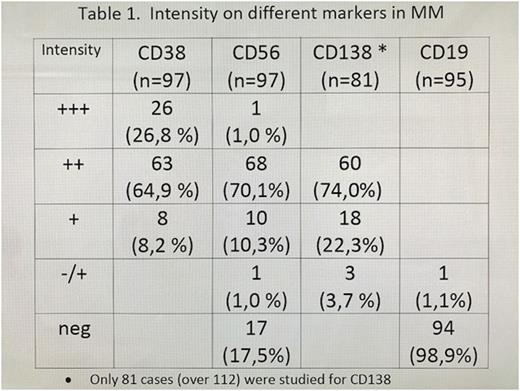Abstract
Flow cytometry is an important tool for the diagnosis and follow-up of hematologic patients. Recently, protocols of EUROFLOW have been implemented, which is a division of ESLHO (European Scientific Foundation for Laboratory Hemato-Oncology) which developed and standardized the flow cytometry tests to make them fast, accurate and highly sensitive for the diagnosis and prognostic classification of hematological malignancies as well as for the evaluation of the effectiveness of treatment during followup including multiple myeloma (MM) cases.
According to the Euroflow protocol, 12 different markers are used for the exact identification and characterization of the phenotype of the plasma cells against aberrant populations. We thus have MM cells showing a phenotypic pattern characteristically by the expression of CD38lo, CD45neg, CD19neg, CD56Hi, CD117pos, CD27neg and CD81lo.
During January 2015 and July 2017; 112 bone marrow samples were studied from patients in morphological complete remission and underwent MM residual disease (MMRD) assessment with Euroflow protocol. Bone marrow samples were studied from patients after induction with different chemotherapies treatment. MMRD by flow cytometry were as follow: in 29,4% (n = 33) of the cases had MMRD ≤0,01%; in 20,5 % (n = 23) cases had MMRD between 0,01% and ≤0,1%; in 22,3 % (n = 25) cases presented MMRD between 0,1% and ≤1%; in 17,8% (n = 20) cases presented MMRD between 1,0% and ≤5%;and finally in 9,8% (n = 11 ) cases had MMRD > 5% .
With 500,000 events: 33% (37 of 112) of samples present an average of 1.11% myeloma cells and an average of 0,18% plasma cells. With 1 000 000 events: 61% cases (68 of 112) of samples have an average of 0.98 % myeloma cells and an average of 0,17% plasma cells. We analyzed the expression of different CD marker intensity (table 1)
This is the first Peruvian report to address MMRD by flow cytometry and different CD markers intensity. The Euroflow protocol showed sensitivity and specificity to detect MMRD positivity, in cases with morphological report as complete remission. There are already studies that refer to the need to acquire 10 million events in MMRD studies to increase the power of the test
No relevant conflicts of interest to declare.
Author notes
Asterisk with author names denotes non-ASH members.


This feature is available to Subscribers Only
Sign In or Create an Account Close Modal